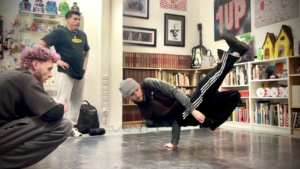The Olympics is Breaking in more ways than one
For most practitioners of a fringe sport, the Olympics is the ultimate dream. Simply participating in this mega event is a huge achievement. With 10,500 athletes taking part this year on a planet of nearly 8 billion people, you literally need to be one in a million. And taking home a medal – that’s the achievement of a lifetime.
Breaking – commonly known as ‘Breakdancing’ – is set to shake up Paris this year as it gets ready for its Olympic debut. The excitement within the community is palpable. But that’s not the consensus. There’s a train of thought that sees the five rings as the fatal adulteration of an art form that embodies creativity, spontaneity, and freedom.
https://twitter.com/SportsGazette/status/1772340081749115252?s=20
It’s the age-old conundrum of old school vs new school. But here’s a dance form that came up from the streets of The Bronx, New York. Where the African-American and Latino youth spontaneously broke into dance during the part of the song when the vocals faded out i.e. the ‘break’ of a track. Moreover, with the term ‘Breakdance’ being a modern-day mistake when referring to ‘Breaking’, old school may be the only acceptable school of thought.
Cracks in the culture
Some key elements of Breaking culture include cyphers, clubs and crews. Cyphers refer to the space created by a ring of onlookers wherein the dancers ‘get down’. Clubs were the hotspots of the art form, and crews weren’t just a group of dancers who came together. They meant more.
Community has clearly been at the forefront when it comes to Breaking culture. One man who gets that is Juan David Gaviria aka B-boy Spin. He’s been Breaking for over 20 years, been a part of multiple crews and been a first-hand witness to the evolution of the dance. And while he’s excited about the new age of Breaking, he does recognise its shortcomings.

Juan David Gaviria aka B-boy Spin
“The scene is being dominated more by the competitive and commercial aspects than the cultural aspects,” Gaviria said. “There’s a lot of people that are into Breaking at the moment that aren’t actually into Breaking culture, let alone hip-hop culture, which is all one thing really.”
“I don’t think there’s any value in being in a crew unless you value that side of the culture. If you don’t appreciate that, it’s kind of hard to appreciate the benefits of being in a crew, representing a crew, and wanting to build with a group of people and having a philosophy to live by.”
On 9th and 10th August 2024, sixteen B-Boys and sixteen B-Girls will compete against each other in solo battles with a dream of Olympic gold in their eyes. Individual accolades will be at the heart of their aspirations.

Gaviria and his crew, Primal Instincts, in action
Not training, just breaking
Another qualm about Breaking’s presence at this megaevent is the idea of a set of Olympic judges quantifying the quality of this dance form. They may even have a checklist. Without trying to sound too poetic: Art is subjective and rating it objectively might just sap its essence.
Sports that require judges to conclude their results have often led to debates that have no perfect resolution. Ultimately the art and artist suffer most.
Gaviria’s Instagram is filled with clips of him lost in his art. One could look at it and think that he’s practicing a routine. But calling it ‘practice’ or a ‘routine’ would be doing him a disservice. A caption from his post from 8th January 2024 gives you an insight into this mindset.
“Not training, just breaking,” he wrote.
“The one thing I hope to never lose, is breaking for breaking sake. Enjoying the craft, enjoying it to different music, sharing ideas with peers and creating vibes in the process. As opposed to only having the disciplined approach necessary to prepare for competitions,”
“This is when I find I allow myself to be more expressive and/or more creative with my dance.”
A scoring system to rate creativity runs the risk of squeezing the freedom out of the act. And freedom was the foundation on which Breaking was built.
Breaking is set to become the first dance sport ever at the Olympics
One and done
In other news, even before making its debut, Breaking has been given the snub for the 2028 Olympics set to be held in Los Angeles. And after the roaring commercial success of the Indian Premier League, Cricket has made its way back into the games for LA.
A sport that’s barely played outside of the small bubble of former British colonies. Such decisions do make you wonder which direction the grand old Olympic Games are heading in.
Nonetheless, 2024 has the potential to be transformative for the sport of Breaking. It’s been a long journey from the asphalt of the Bronx to the pristinely padded mats of Paris. And we’ll be watching on keenly come August. But you have to ask, was this how it was meant to be?
In its early days in New York, Breaking was a tool to settle turf disputes by way of creative expression. It was a physical, yet non-violent path to duel. A civil rebellion. Fast forward 50 years and it’s now a sport that’s conforming with the standards of the Olympics. Its evolution was inevitable, but the culture will remain inimitable.